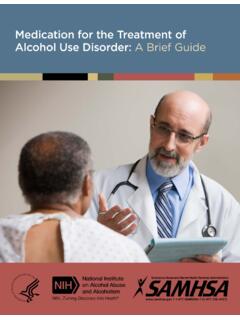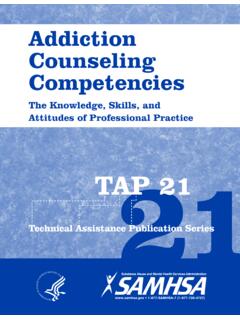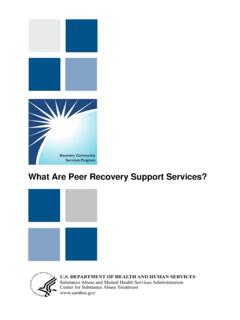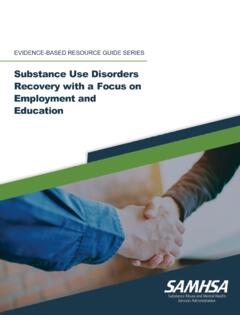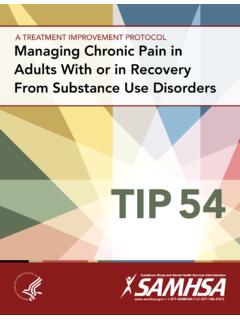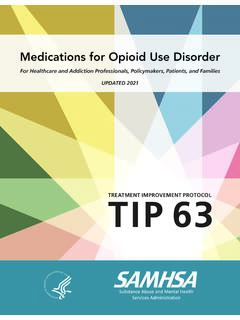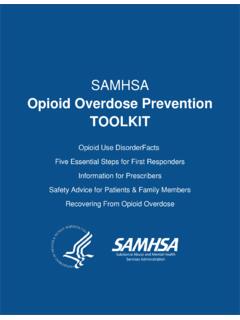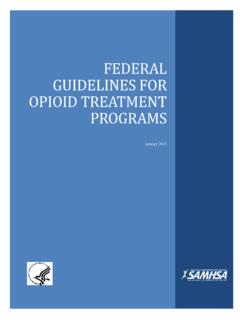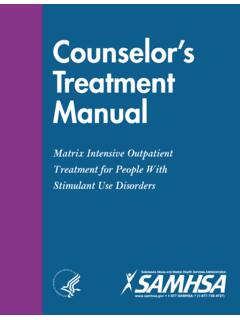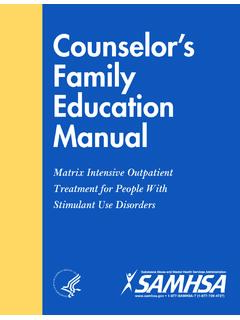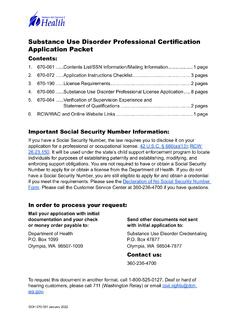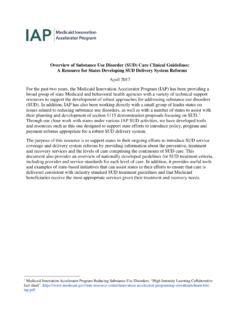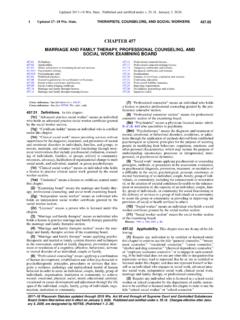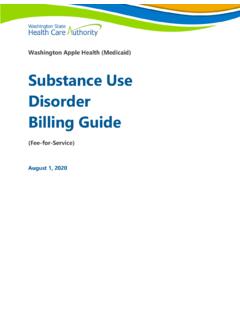Transcription of Substance Use Disorder Treatment for People with Co ...
1 Substance USE Disorder Treatment FOR. People with CO- occurring disorders . Introduction Guiding Principles for Working with The term co- occurring Disorder (COD) refers Individuals with CODs to the condition of having at least one mental Disorder and at least one Substance use 1. Use a recovery perspective Disorder (SUD). Of the million adults with 2. Adopt a multi-problem viewpoint any past-year mental illness in 2019, million 3. Develop a phased approach to Treatment had both any past-year mental illness and a 4. Plan to address the client's cognitive/. SUD ( Substance Abuse and Mental Health functional concerns Services Administration [SAMHSA], 2020a). 5. Use support systems to maintain and CODs are strongly associated with extend Treatment effectiveness socioeconomic and health factors that can challenge recovery, such as unemployment, homelessness, criminal justice system involvement, and suicide (SAMHSA, 2020b).
2 In 2019, percent (or million) of adults aged 18 and older with CODs received either Substance use Treatment at a specialty facility or mental health services in the past year, percent (or million People ) received mental health services only, and percent (or 742,000 People ) received both (SAMHSA, 2020a). Given the prevalence of CODs in the United States, providers and administrators must focus on the nuances of treating this population. It is important for providers to work with clients to create a comprehensive, individualized plan to treat both disorders and achieve better client outcomes. This Advisory is based on the SAMHSA's Treatment Improvement Protocol (TIP) 42, Substance Use Disorder Treatment for People with Co- occurring disorders .
3 It highlights strategies for counselors and administrators to properly screen, assess, diagnose, and manage the Treatment of individuals with CODs. Key Messages People with SUDs are more likely than those without to have co- occurring mental disorders (NIDA, 2020). Mental disorders likely to co-occur with addiction include depressive disorders , bipolar I Disorder , post-traumatic stress Disorder (PTSD), personality disorders (PDs), anxiety disorders , schizophrenia and other psychotic disorders , ADHD, and eating disorders (Hasin & Grant, 2015). 1. ADVISORY. Key Messages(cont.). Serious gaps exist between the Treatment and service needs of People with CODs and the actual care they receive. Many factors contribute to the gap, such as lack of awareness of and training in CODs by addiction counselors, as well as workforce factors like labor shortages and professional burnout (SAMHSA, 2020b).
4 Failure to routinely screen clients for mental disorders and SUDs creates a problematic domino effect. A lack of screening means a lack of assessment. This results in a lack of diagnosis, which leads to a lack of Treatment , and ultimately reduces a person's chances of achieving long-term recovery for either or both disorders . Providers can prevent this cascade by understanding how to screen, perform a full assessment, and recognize the diagnostic symptoms of mental disorders and SUDs. CODs are treatable conditions. Providers can implement a range of Treatment modalities across numerous inpatient and outpatient settings. Counselors may need to adapt interventions based on the Treatment setting and the unique needs and characteristics of clients, including their gender, race, ethnicity, life circumstance ( , homelessness, involvement in the criminal justice system), symptoms, functioning, stage of change, risk of suicidal thoughts and behaviors, and trauma history.
5 People with CODs are at an elevated risk for self-harm, especially if they have a history of trauma (Haviland et al., 2016; Wisner et al., 2013). Providers should make client safety a priority and ensure staff have the necessary training to detect and respond to suicidal thoughts and behaviors in clients with CODs. Essential services for People with CODs are person-centered, trauma-informed, culturally sensitive, recovery-oriented, comprehensive, and continuously offered across all levels of care and the disease course. There is no wrong door by which People with CODs arrive at Treatment . Counselors and programs should have a range of interventions and services in their toolbox to help clients. Administrators and supervisors must respond to workforce challenges, such as unmet training needs, low employee retention, staff burnout, and low competency in advanced COD management skills.
6 Such workforce issues are directly tied to Treatment availability and quality and should be taken seriously and addressed actively by all COD Treatment programs. Core Components for Counselors and Providers Providing access Access to care is the process by which an individual with COD makes initial contact with the service system, receives an initial evaluation, and begins appropriate interventions. Types of access include: 1. Routine access to Treatment for individuals who are not in crisis 2. Emergency access for individuals in crisis 3. Outreach to individuals with significant needs ( , People experiencing homelessness) who are not seeking services or cannot access ordinary or crisis services 4. Access that is involuntary or mandated by the criminal justice system, employers, or the child welfare system 2.
7 SAMHSA'S mission is to reduce the impact of Substance abuse and mental illness on America's communities. 1-877-SAMHSA-7 | (1-877-726-4727) 1-800-487-4889 (TDD) ADVISORY. Completing a Full Assessment Assessment involves a combination of: Screening to detect the presence of CODs Evaluating background factors, mental disorders , SUDs, and related medical and social problems critical for Treatment planning Diagnosing the type and severity of SUDs and mental disorders Matching the client to initial services Appraising the client's needs for social and community support services Conducting continuous evaluation Providing an appropriate level of care Whenever possible, clients should be Exhibit 1. The Four Quadrants Model placed in a level of care appropriate to the functional challenges, severity of Mental Disorder symptoms, and recovery environment Low High aligned with both their SUD and III Less severe IV More severe their mental disorders .
8 Several High mental Disorder / mental Disorder /. models are available for clinicians Substance more severe SUD more severe SUD. to determine which level of care is Use I Less severe II More severe best. The Level of Care Utilization Disorder mental Disorder / mental Disorder /. Low System (LOCUS) by the American less severe SUD less severe SUD. Association of Community Psychiatry is a model describing six levels of care that increase in intensity based on a client's assessment across six dimensions (American Association for Community Psychiatry, 2020). The Four Quadrants Model classifies clients into four groups based on symptom severity, as detailed in Exhibit 1 (Ries, 1993). Achieving integrated Treatment Integrated care is the preferred model of Treatment for individuals with CODs.
9 SAMHSA's Practice Principles of Integrated Treatment for CODs are shown in the box below. SAMHSA's Practice Principles of Integrated Treatment for CODs 1. SUDs and mental disorders are treated concurrently to meet the full range of clients' symptoms. 2. Providers of integrated care receive training in the Treatment of both SUDs and mental disorders . 3. CODs are treated with a stepwise approach tailored to the client's stage of readiness for Treatment ( , engagement, persuasion, active Treatment , relapse prevention). 4. Motivational techniques ( , motivational interviewing, motivational counseling) are integrated into care to help clients reach their goals, particularly at the engagement stage of Treatment .
10 5. Addiction counseling is used to help clients develop healthier, more adaptive thoughts and behaviors in support of long-term recovery. 6. Clients are offered multiple Treatment formats, including individual, group, family, and peer support, as they move through the various stages of Treatment . 7. Pharmacotherapy is discussed in multidisciplinary teams, offered to clients when appropriate, and monitored for safety ( , interactions with other medications), adherence, and response. 3. SAMHSA'S mission is to reduce the impact of Substance abuse and mental illness on America's communities. 1-877-SAMHSA-7 | (1-877-726-4727) 1-800-487-4889 (TDD) ADVISORY. Providing comprehensive services Along with Treatment for SUDs and mental disorders , individuals with CODs often need additional services, such as life skills development, English as a second language, parenting, nutrition, vocational assistance, and others.
